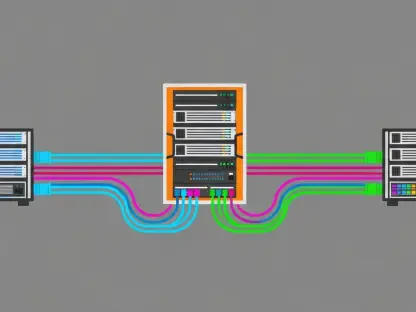The evolving landscape of cloud services and the rise of artificial intelligence (AI) have brought data center interconnectivity to the forefront of technological advancements. As global demand for cloud services continues to surge, data centers have become pivotal in supporting these advancements. The rise of AI, which requires substantial computational power, is expected to significantly amplify data traffic, posing new challenges and opportunities in data center operations. These challenges necessitate not only expanding the capacity of data centers but also enhancing the interconnected framework that allows for seamless data flow between them. The critical role of efficient data center interconnectivity cannot be overstated, as it forms the backbone of our rapidly advancing digital world and supports the explosive growth of high-demand applications.
The Growing Demand for Data Center Capacity
Data center capacity in the Asia Pacific is projected to reach 94.4GW by 2028, driven primarily by the adoption of AI and cloud services. While Singapore has historically been a dominant market player in this field, other countries in Southeast Asia are increasingly developing high-performance IT infrastructure, signaling a broader regional shift in technological capabilities. This growth does not merely highlight the importance of increasing the number of data centers but also underscores the necessity of enhancing the connectivity between these centers. Connecting data centers efficiently ensures that the infrastructure can handle the growing data traffic seamlessly and securely, providing essential support for the technological advancements spurred by AI and cloud services.
As AI and other bandwidth-intensive applications continue to emerge, they necessitate a novel operational approach to data center management. This creates a plethora of opportunities for various stakeholders in the industry. Investors, developers, operators, and global cloud service providers all stand to benefit significantly from improved data transfer resilience and efficiency. A strategic approach involving multiple, geographically dispersed centers can help manage the increasing data traffic while providing better resilience and operational efficiency. This geographical diversification means that data centers must exist beyond central urban locales, expanding to various parts of the country and demanding robust, secure, and fast interconnectivity.
The Role of Data Center Interconnectivity
There are approximately 8,000 data centers globally, with enterprises typically connected to more than one. However, data centers do not operate in hermetic isolation. Improved data transfer resilience and efficiency often require the strategic use of multiple, geographically dispersed centers. This diversification means that data centers must now exist beyond central urban locales, extending to various parts of the country, thus demanding robust, secure, and fast interconnectivity. By enhancing interconnectivity, data centers can ensure data resiliency, operational efficiency, and provide better service delivery to users.
The shift in application consumption, particularly with the rise of AI, necessitates changes in connectivity delivery methods. The AI adoption process is divided into two distinct phases. Currently, we are in the large language model (LLM) training phase. This phase is highly intensive in terms of power, storage, computation, and network resources. During this period, vast datasets are processed through artificial neural networks comprising billions to trillions of parameters. The goal is to train these models to emulate human-like decision-making tasks, which requires intense computational efforts and high-volume data transfers within interconnected data centers.
The Importance of Edge Computing
The second phase in AI adoption, termed the inference phase, begins once these models are trained and ready for practical applications using real-world data. Unlike the training phase, this phase is less power and compute-intensive but is considerably more geographically distributed. Such a distribution fosters a strong business case for edge computing applications that require low-latency decision-making processes. These applications are crucial in scenarios like smart city developments, where numerous sensors, cameras, IoT devices, and other technologies generate extensive continuous data streams.
Traditional core cloud computing faces inherent latency and bandwidth challenges due to the physical distance between the core and the edge, where the data is originated and consumed. Edge computing mitigates these issues by processing data closer to the source, thereby enhancing real-time insights, faster decision-making, and user experiences. By processing data near the source, edge computing reduces the need for long-distance data transmission, which can be a significant bottleneck in traditional cloud computing architectures. This approach ensures that the data services are more responsive and efficient, which is essential for applications that rely on real-time data processing and analysis.
Managing Network Strains and Leveraging Opportunities
One pressing issue identified in the context of data center operations is the management of increasing network strains. This is especially pertinent among routes leading to, from, and between data centers. The challenge lies in leveraging opportunities within constrained budgets and limited resources. Although AI’s demand for computing and storage power is expected to continue fueling data center growth, the next growth phase in the data center industry will be driven by interconnectivity. Efficient interconnectivity between data centers is essential to manage the massive data traffic generated by new technologies and applications.
Data Center Interconnect (DCI) technology is critical in this context, as it links two or more data centers over various distances using high-speed packet-optical connectivity. Companies like StarHub and VITRO Inc. increasingly recognize DCI’s importance in delivering the scalability and efficiencies required for a hyper-connected world. DCI solutions enable seamless data transfers between geographically dispersed data centers, ensuring that data traffic flows smoothly and efficiently. This capability is crucial for maintaining high levels of performance and reliability in interconnected data center operations.
Ensuring Secure and Reliable Connectivity
Research supports the continuation of data center growth over the coming years, with businesses anticipating the construction of additional data centers. These businesses must consider key connectivity factors to support applications effectively. DCI-optimized networking ensures secure and reliable data placement when and where needed. Operational simplicity designed into the right DCI platform facilitates hassle-free, rapid scalability. A well-designed DCI platform enables businesses to scale their operations quickly and efficiently, ensuring they can meet the growing demands of their users without significant downtime or operational inefficiencies.
Modern DCI solutions are designed with common management interfaces and industry-standard APIs, allowing businesses to automate many labor-intensive tasks. This automation reduces errors associated with repetitive operations and enhances overall operational efficiency. Additionally, the openness to programmability in DCI platforms enables smooth integration with existing back-office tools, further streamlining data center operations. By leveraging these advanced technologies, businesses can achieve higher levels of operational efficiency and performance in their data center environments.
The Critical Role of Low Latency
Latency is another critical consideration in data center interconnectivity, particularly for industries like financial services and the burgeoning cloud service provider ecosystem. Low latency ensures that data travels swiftly between data centers, which is essential for maintaining efficient and responsive connectivity. For businesses that rely on real-time data processing and transactions, low latency is a non-negotiable requirement. It ensures that data operations are completed swiftly and accurately, which is crucial for maintaining competitive advantage and operational efficiency in these industries.
An example of addressing latency concerns is StarHub’s Low Latency Data Center Connect service. This service is designed to provide seamless interconnection and enhanced access to cloud services and applications. By reducing latency and improving data transfer speeds, StarHub aims to improve customer and user experiences while reducing costs and increasing operational efficiency. This service highlights the importance of low latency in modern data center operations and the benefits it can bring to businesses and end-users alike.
Preparing for Future Bandwidth Demands
There are around 8,000 data centers globally, with businesses usually connected to multiple ones. These data centers don’t work in isolation; they need to share data for improved resilience and efficiency. To achieve this, using multiple data centers in various locations is essential. This means data centers are no longer just in central cities but spread across the country. They require strong, secure, and fast interconnectivity. Improved interconnectivity helps data centers maintain data resilience, enhance operational efficiency, and deliver better services to users.
With changing application consumption and the rise of AI, connectivity methods need updating. The AI adoption process has two main phases. We are now in the large language model (LLM) training phase, which is highly demanding in terms of power, storage, computation, and network resources. This involves processing large datasets through neural networks with billions to trillions of parameters. The aim is to train these models for tasks that mimic human decision-making, requiring significant computational efforts and massive data transfers between interconnected data centers.









